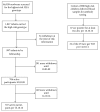Environmental trigger(s) of type 1 diabetes: why so difficult to identify?
- PMID: 25883954
- PMCID: PMC4390105
- DOI: 10.1155/2015/321656
Environmental trigger(s) of type 1 diabetes: why so difficult to identify?
Abstract
Type 1 diabetes (T1D) is one of the most common chronic diseases with childhood onset, and the disease has increased two- to fivefold over the past half century by as yet unknown means. T1D occurs when the body's immune system turns against itself so that, in a very specific and targeted way, it destroys the pancreatic β-cells. T1D results from poorly defined interactions between susceptibility genes and environmental determinants. In contrast to the rapid progress in finding T1D genes, identification and confirmation of environmental determinants remain a formidable challenge. This review article will focus on factors which have to be evaluated and decision to take before starting a new prospective cohort study. Considering all the large ongoing prospective studies, new and more conclusive data than that obtained so far should instead come from international collaboration on the ongoing cohort studies.
Figures

Similar articles
-
Type 1 diabetes: prospective cohort studies for identification of the environmental trigger.Arch Immunol Ther Exp (Warsz). 2013 Dec;61(6):459-68. doi: 10.1007/s00005-013-0247-9. Epub 2013 Aug 18. Arch Immunol Ther Exp (Warsz). 2013. PMID: 23955530 Review.
-
[Environmental causes of type 1 diabetes].Tidsskr Nor Laegeforen. 2007 Sep 20;127(18):2405-8. Tidsskr Nor Laegeforen. 2007. PMID: 17895949 Norwegian.
-
Glutathione-s-transferase M1 and T1 polymorphisms and associations with type 1 diabetes age-at-onset.Autoimmunity. 2005 Dec;38(8):567-75. doi: 10.1080/08916930500407238. Autoimmunity. 2005. PMID: 16390810
-
The rising incidence of childhood type 1 diabetes and reduced contribution of high-risk HLA haplotypes.Lancet. 2004 Nov 6-12;364(9446):1699-700. doi: 10.1016/S0140-6736(04)17357-1. Lancet. 2004. PMID: 15530631
-
14th International HLA and Immunogenetics Workshop: report on the HLA component of type 1 diabetes.Tissue Antigens. 2007 Apr;69 Suppl 1:214-25. doi: 10.1111/j.1399-0039.2006.00772.x. Tissue Antigens. 2007. PMID: 17445204 Review.
Cited by
-
Peroxiredoxin 6 Attenuates Alloxan-Induced Type 1 Diabetes Mellitus in Mice and Cytokine-Induced Cytotoxicity in RIN-m5F Beta Cells.J Diabetes Res. 2020 Aug 25;2020:7523892. doi: 10.1155/2020/7523892. eCollection 2020. J Diabetes Res. 2020. PMID: 32908936 Free PMC article.
-
Familial aggregation and heritability of type 1 diabetes mellitus and coaggregation of chronic diseases in affected families.Clin Epidemiol. 2018 Oct 10;10:1447-1455. doi: 10.2147/CLEP.S172207. eCollection 2018. Clin Epidemiol. 2018. PMID: 30349392 Free PMC article.
-
Environmental exposures in machine learning and data mining approaches to diabetes etiology: A scoping review.Artif Intell Med. 2023 Jan;135:102461. doi: 10.1016/j.artmed.2022.102461. Epub 2022 Nov 30. Artif Intell Med. 2023. PMID: 36628796 Free PMC article.
-
Impact of the Exposome in Type 1 Diabetes: Protocol for a Scoping Review.JMIR Res Protoc. 2025 Jul 17;14:e73424. doi: 10.2196/73424. JMIR Res Protoc. 2025. PMID: 40674727 Free PMC article.
-
Type 1 Diabetes incidence among youth in Utah: A geographical analysis.Soc Sci Med. 2021 Jun;278:113952. doi: 10.1016/j.socscimed.2021.113952. Epub 2021 Apr 19. Soc Sci Med. 2021. PMID: 33933801 Free PMC article.
References
-
- Patterson C. C., Dahlquist G. G., Gyürüs E., Green A., Soltész G. Incidence trends for childhood type 1 diabetes in Europe during 1989–2003 and predicted new cases 2005–20: a multicentre prospective registration study. The Lancet. 2009;373(9680):2027–2033. doi: 10.1016/S0140-6736(09)60568-7. - DOI - PubMed
Publication types
MeSH terms
Substances
LinkOut - more resources
Full Text Sources
Other Literature Sources
Medical
Miscellaneous

